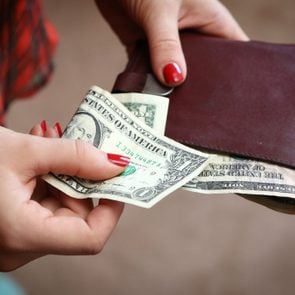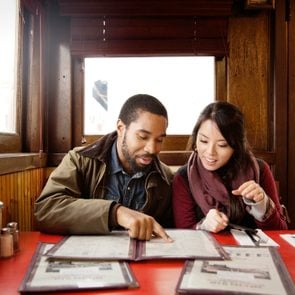How to Set a Table for Any Occasion
Updated: Jan. 25, 2024
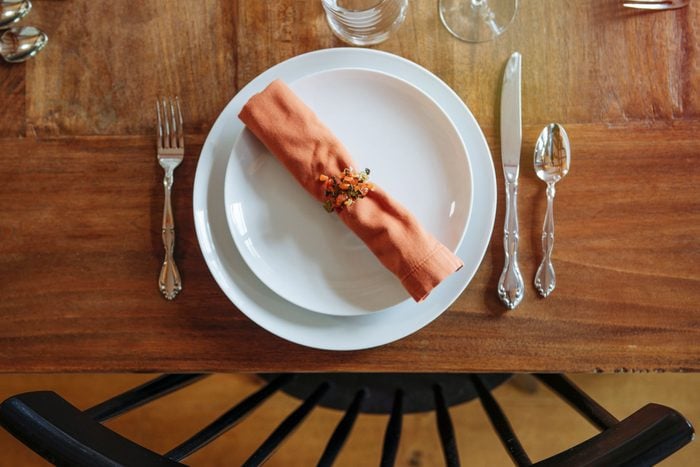
Not sure how to set a table properly? Whether you're planning a casual gathering or a formal, intimate dinner, this is table-setting etiquette you need to know.
Dining habits have changed drastically over the years. And while dining etiquette is still just as valuable as good table manners, some more traditional expectations have fallen by the wayside, including knowing how to set a table properly. Whether you’re hosting a casual lunch or a formal holiday dinner party, a beautifully appointed table both elevates the food you’re serving and shows respect to the guests you’ve invited.
The type of table setting you choose indicates to your guests the level of formality of your event. It also signals to them that you value their presence and wish to go the extra mile to prepare a well-set table.
And while learning how to set a table for various situations is a good skill to have in your hosting arsenal, we know that a proper table setting can be intimidating. But as etiquette expert Maryann Parker notes, it’s just about making people comfortable. “We just need to know a few basic rules to be comfortable and never intimidated by the prospect of navigating the table setting,” Parker says. “For informal dining, we do not need the most expensive china to feel special, sophisticated and classy. We can easily improvise!”
Get Reader’s Digest’s Read Up newsletter for etiquette, humor, cleaning, travel, tech and fun facts all week long.
How to set a basic table
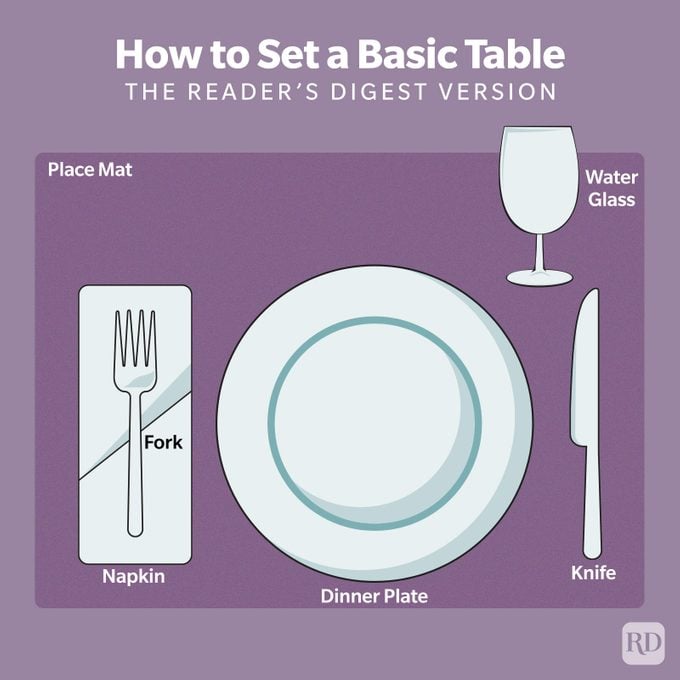
A basic table setting is the go-to approach for weeknight family dinners or casual outdoor gatherings. You don’t need much, says Parker, and this is the least formal option. The difference between a basic table setting and a more formal one is generally the number of utensils you see. You’ll want to include a plate, knife, fork, napkin and water glass. And here’s a pro tip: Regardless of your tablescape’s formality, don’t make this common etiquette mistake: “Knives are always presented on the right side and with the blade facing in. Forks are always placed on the left,” Parker says.
- If you have them, start with a place mat or tablecloth to protect your table.
- Place your dinner plate on the place mat.
- Fold your napkin and position it to the left of the dinner plate.
- Place your fork on top of the napkin.
- Position your knife to the right of your plate (blade facing the plate).
- Place your water glass on the table above your plate, slightly to the right.
How to set a casual table
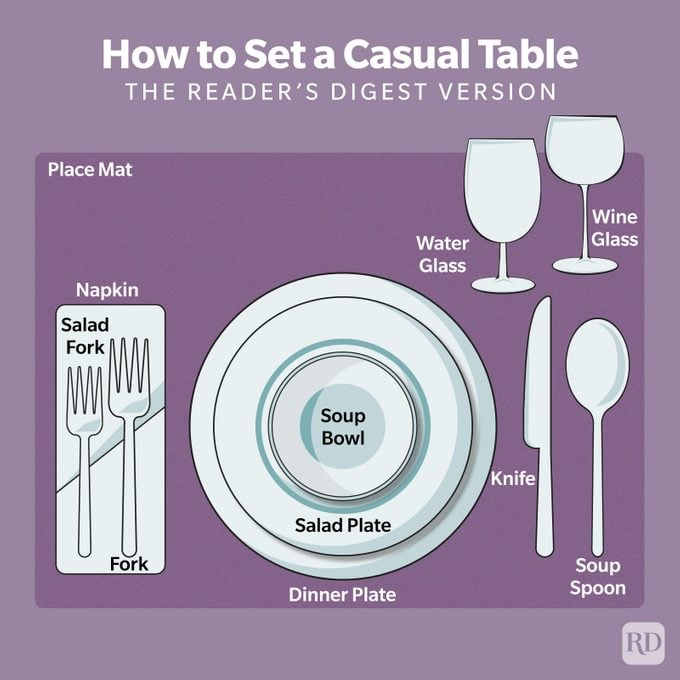
Suppose you’re hosting an informal dinner party (like a Friendsgiving or something a bit more elevated than a weeknight family dinner). Advancing your table setting from basic to casual can mean including additional glassware in the form of a wine glass, upgrading your napkins from paper to linen or adding a salad plate and fork (and/or a soup bowl and spoon). “Everything is rather simplified,” notes Parker. While this is a bit more elevated, you are still not using charger plates, a white tablecloth or a variety of utensils.
“It doesn’t have to be a lot of work,” says etiquette expert Lisa Grotts. “You can still have a three-course meal and just have two forks and a soup spoon. The place setting itself doesn’t have to be intimidating.” Armed with that knowledge, here’s how to set a casual table.
- Start with a place mat or tablecloth.
- Place your dinner plate on the place mat.
- If needed, add a salad plate and/or a soup bowl on top of the dinner plate.
- Fold your napkin and position it to the left of the dinner plate.
- Place your fork on top of the napkin—remember, forks and napkins always go to the left!
- If needed, position your salad fork to the left of the dinner fork.
- Position your knife to the right of the dinner plate.
- If needed, position your soup spoon to the right of the knife.
- Place your water glass on the table, above and slightly to the right of your dinner plate.
- Add a wine glass slightly above and to the right of the water glass.
How to set a formal table
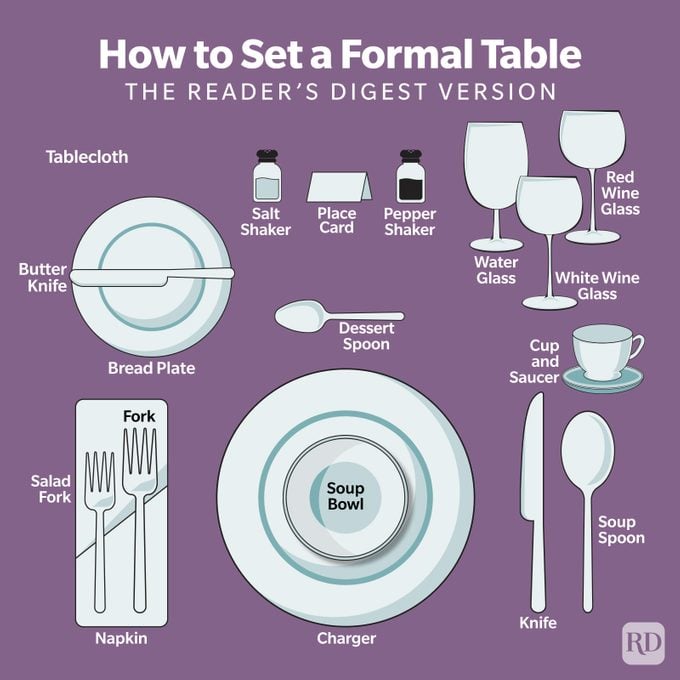
Hosting a formal dinner party, wedding or an event that requires a formal RSVP? It’s time for a formal table setting. “Think birthdays, anniversaries, New Year’s Eve or any really special occasion,” Grotts says. A formal table setting will include far more utensils and plates than a basic or casual setting. In addition to your dinner plate and basic forks and knives, you’ll also find a bread plate and butter knife, a cup and saucer for coffee or tea, dessert utensils and possibly two (or three) types of wine glasses, in addition to your water glass. Since it’s more formal, it’s more likely that a formal tablecloth will be used instead of a more casual place mat.
“It’s more than just the place settings,” notes Grotts. “It’s the props too—the menu card, place card, special flowers, etc.” This is the time to let your creativity shine, and Parker agrees. “Flower arranging is a crucial element for a successful table setting.” Of course, when choosing flowers for your formal table, be sure to create lower arrangements that don’t block guests’ sightlines and flowers that are not overly scented. Here’s how you can set a formal table:
- Cover your table with a crisply ironed tablecloth.
- Place a charger down on the table.
- Set your soup bowl on top of the charger (soup is typically the first course, followed by salad and then the main course—your salad and subsequent main course would be brought out to you and set on the charger following the completion of your first course).
- Position your bread plate slightly above and to the left of the charger.
- Place your butter knife on the bread plate, with the blade facing in, toward the charger.
- Place your napkin to the left of the charger.
- Place your dinner fork on top of the napkin.
- Position your salad fork to the left of the dinner fork.
- Position your knife to the right of the charger.
- Add your soup spoon to the right of the knife.
- Right above the charger, position a dessert spoon horizontally, with the handle on the right side.
- If guests will be using individual salt and pepper shakers, they can go above the dessert spoon.
- If you’re using place cards, place them above the dessert spoon, in between individual salt and pepper shakers, if necessary.
- Add your glassware. First, place your water glass slightly above and to the right of the charger. Then, add a red wine glass to the top right of the water glass. Last, add a white wine glass to the bottom right of the water glass. You might also add additional glassware, such as champagne or sherry glasses, if the occasion calls for it.
- You can set your coffee cup and saucer on the table now, or you can bring it out when you serve dessert. If you set it out now, place it on the bottom right of the glassware.
FAQs
How do you set a table for lunch?
Having guests over for an informal luncheon? A lunch table setting can mimic your basic or casual table setting. Because it’s lunch, you’d likely omit the wine glasses and stick to a water glass for your drinkware.
What can you leave out of a formal table setting?
Both Grotts and Parker agree that there’s one element of a formal table setting that can be left in the cupboard: the finger bowl. Finger bowls are brought to the table at the time of the dessert course so guests can rinse their fingers. “They’re a thing of the past,” says Grotts. Parker also says that fish knives can be left in the cutlery drawer. “No one will be using a fish knife during an informal dinner, and in fact, it’s not even a proper utensil,” she says.
Where do forks go on a table setting?
Remember this: Forks always go on the left, no matter the formality of the place setting. With that in mind, knives always go on the right with the blade pointing in, and a soup spoon joins the knife on the right, if soup is part of your meal.
What’s the golden rule of table setting?
Both our etiquette experts agree: Utensils should always be placed in the order that they will be used, from the outside in. “I’m reminded of the movie Pretty Woman,” says Grotts. “You always work out to in when you’re eating.”
How do you remember where to put everything?
If you’re having trouble remembering where everything is supposed to go on your table, keep the BMW logo in mind, says Parker. That means (from left to right) bread, main course, water.” Or you can make a lowercase “b” and “d” with your hands. Bread on the left, drinks on the right.
About the experts
- Maryann Parker is the founder and executive director of Manor of Manners, a company that specializes in luxury etiquette teachings. She has almost a decade of experience in helping the interests of luxury brands, businesses and individuals. She is also the author of two books, The Sharpest Soft Skill and Posh Overnight.
- Lisa Grotts is a 23-year certified etiquette expert who helps clients and readers deal with business, social and political situations. Lisa is a former director of protocol for the city and county of San Francisco, a certified etiquette professional and a past member of the International Society of Protocol and Etiquette Professionals.

